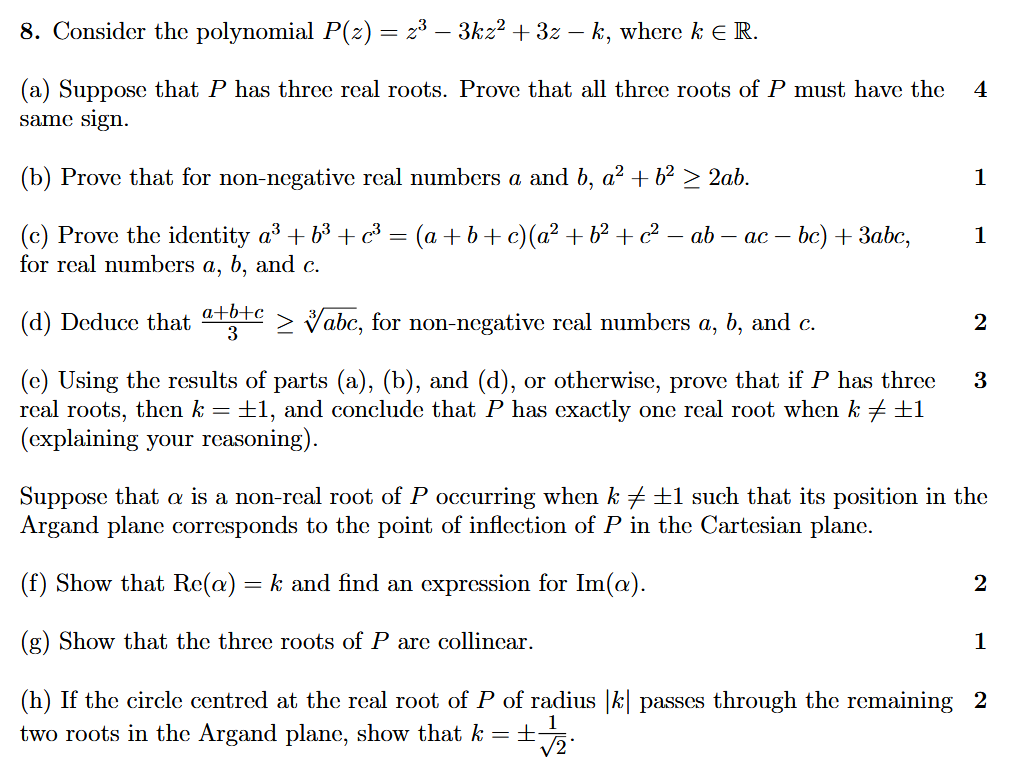aa180
Member
Just a fun question I made up.


Last edited:
Students helping students, join us in improving Bored of Studies by donating and supporting future students!

I didn't address those because they seemed trivial to me - my bad.It looks good, BUT... when you were showing thatboth have the same sign for any
(in fact, the same sign as
), there should be a total of four cases to consider. These are:
1)
2)
3)
4)
You only addressed the first two of these cases, and then stated thatfrom which you concluded what you were trying to prove. I just don't see how it follows from that, without proving cases 3 and 4 directly as you did with 1 & 2.
Lol, I didn't even see that - yes, they are trivial..whoops.I didn't address those because they seemed trivial to me - my bad.
Ifis positive, then
must be positive since two positive numbers are being added.
Ifis negative, then
must be negative too since a positive number is being subtracted from a negative number.
Yep, you can also use that same line of reasoning for the proof by contradiction approach.Another way to think about it is that iffor positive
then it follows that
i.e. the magnitude of
is always greater than the magnitude of
. Therefore, adding or subtracting
can never change the sign of
.
You are actually correct. I just remembered that a while ago when I was trying to come up with polynomials questions, I tried to set one up that had a monic cubic equation with the remaining coefficients being all arbitrary, such that the cubic had a non-real root corresponding to its point of inflection in the real plane, and I derived pretty much the same contradiction you found - that the point of inflection of the cubic will forcibly coincide with the real root of the polynomial, which then gives three real roots instead of one. I must've completely forgotten about this when I was busy writing this question.I'm having some trouble with part (h).
If one of the non-real roots had real part, then by the complex conjugate root theorem, the sum of the two non-real roots should be
.
Then, using the sum of roots, the last root should be.
Butis the point of inflection of
.
So therefore the point of inflection lies on a root, meaning thatshould have a triple root at
, which contradicts the question.
To double-check, I substitutedinto
and put it into Wolfram Alpha to check the roots. The non-real roots did not have real part
.
Have I made a mistake with this reasoning?
Are those not triple roots?If k=1, z^3-3z^2+3z-1=(z-1)^3, if k=-1, z^3+3z^2+3z+1=(z+1)^3, .: exactly one real root each.
I think you need to review your question.
There's one real root of multiplicity 3 whenExactly one real root and no complex roots when k=+/-1.
For other real values of k, there are 3 roots according to the Fundamental Theorem of Algebra, one must be real according to the Conjugate Roots Theorem.
TryI tried k=sqrt(3.5), plotted x and y intercepts and alpha, they are not collinear.
Yeah I just tried that and you're right. I think that means it's impossible to have an imaginary root that lies halfway between the origin and the point of inflection. I'll try a few other ideas and see where it gets me..Also, I noticed that when you find the third (real) root using sum of roots and then sub these three roots into the product of roots, you seem to get an equation with certain solutions forthat contradict the question.
Well since there are still solutions that exist then there should be at least one complex number that works.Yeah I just tried that and you're right. I think that means it's impossible to have an imaginary root that lies halfway between the origin and the point of inflection. I'll try a few other ideas and see where it gets me..
